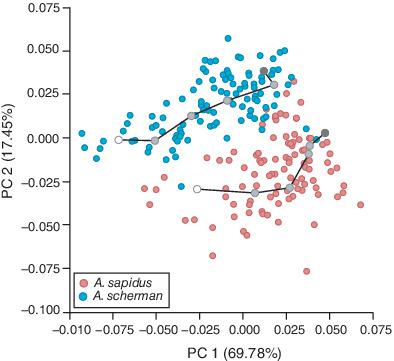当前位置:
X-MOL 学术
›
J. Morphol.
›
论文详情
Our official English website, www.x-mol.net, welcomes your feedback! (Note: you will need to create a separate account there.)
Three‐dimensional geometric morphometric analysis of the humerus: Comparative postweaning ontogeny between fossorial and semiaquatic water voles ( Arvicola )
Journal of Morphology ( IF 1.5 ) Pub Date : 2020-10-10 , DOI: 10.1002/jmor.21278 Ana Filipa Dura˜o 1 , Francesc Muñoz‐Muñoz 1 , Jacint Ventura 1
Journal of Morphology ( IF 1.5 ) Pub Date : 2020-10-10 , DOI: 10.1002/jmor.21278 Ana Filipa Dura˜o 1 , Francesc Muñoz‐Muñoz 1 , Jacint Ventura 1
Affiliation

|
Different types of locomotion in phylogenetically close rodent species can lead to significantly different growth patterns of certain skeletal structures. In the present study, we compared the allometric and phenotypic trajectories of the humerus in semiaquatic (Arvicola sapidus) and fossorial (Arvicola scherman) water vole taxa, using three‐dimensional geometric morphometrics, to investigate the relationships between functional and ontogenetic differences. Results revealed shared humerus traits between A. sapidus and A. scherman, specifically an expansion of the epicondylar and deltopectoral crests along postnatal ontogeny. In both species, the humerus of young specimens is more robust than in adults, possibly as a compensatory response for lower bone stiffness. However, significant interspecific differences were detected in all components of allometric and phenotypic trajectories. Noticeably divergent allometric trajectories were observed, probably as a result of different functional pressures exerted on this bone. Important differences in the form of the adult humerus between taxa were also found, particularly in features located in muscle insertion zones. Furthermore, the allometric regression revealed certain shape variation not associated with size in A. scherman, suggesting mechanical stress produced by the persistent digging activity during adulthood. A. scherman is a chisel‐tooth digger that shares several traits in the humerus morphology with scratch‐digger rodent species. Nevertheless, these shared characteristics are less pronounced in fossorial water voles, which is congruent with the different implications of the forelimb in the digging activity in these two types of diggers.
中文翻译:

肱骨的三维几何形态测量分析:化石和半水生水田鼠(Arvicola)断奶后个体发育的比较
在系统发育上接近的啮齿动物物种中,不同类型的运动会导致某些骨骼结构的生长模式显着不同。在本研究中,我们使用三维几何形态计量学比较了半水生(Arvicola sapidus)和化石(Arvicola scherman)水田鼠类群中肱骨的异速生长和表型轨迹,以研究功能和个体发育差异之间的关系。结果揭示了 A. sapidus 和 A. scherman 之间共享的肱骨特征,特别是随着出生后个体发育的上髁和三角胸嵴的扩张。在这两个物种中,年轻标本的肱骨比成年人的肱骨更强壮,这可能是对较低骨骼刚度的代偿反应。然而,在异速生长和表型轨迹的所有组成部分中检测到显着的种间差异。观察到明显不同的异速生长轨迹,可能是由于施加在该骨骼上的不同功能压力所致。还发现了类群之间成人肱骨形式的重要差异,特别是位于肌肉插入区的特征。此外,异速生长回归揭示了与 A. scherman 大小无关的某些形状变化,表明成年期间持续挖掘活动产生的机械应力。A. scherman 是一种凿齿挖掘机,在肱骨形态学上与划痕挖掘机啮齿动物物种具有多种特征。然而,这些共同特征在古水田鼠中不那么明显,
更新日期:2020-10-10
中文翻译:

肱骨的三维几何形态测量分析:化石和半水生水田鼠(Arvicola)断奶后个体发育的比较
在系统发育上接近的啮齿动物物种中,不同类型的运动会导致某些骨骼结构的生长模式显着不同。在本研究中,我们使用三维几何形态计量学比较了半水生(Arvicola sapidus)和化石(Arvicola scherman)水田鼠类群中肱骨的异速生长和表型轨迹,以研究功能和个体发育差异之间的关系。结果揭示了 A. sapidus 和 A. scherman 之间共享的肱骨特征,特别是随着出生后个体发育的上髁和三角胸嵴的扩张。在这两个物种中,年轻标本的肱骨比成年人的肱骨更强壮,这可能是对较低骨骼刚度的代偿反应。然而,在异速生长和表型轨迹的所有组成部分中检测到显着的种间差异。观察到明显不同的异速生长轨迹,可能是由于施加在该骨骼上的不同功能压力所致。还发现了类群之间成人肱骨形式的重要差异,特别是位于肌肉插入区的特征。此外,异速生长回归揭示了与 A. scherman 大小无关的某些形状变化,表明成年期间持续挖掘活动产生的机械应力。A. scherman 是一种凿齿挖掘机,在肱骨形态学上与划痕挖掘机啮齿动物物种具有多种特征。然而,这些共同特征在古水田鼠中不那么明显,


























 京公网安备 11010802027423号
京公网安备 11010802027423号